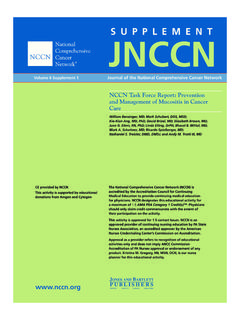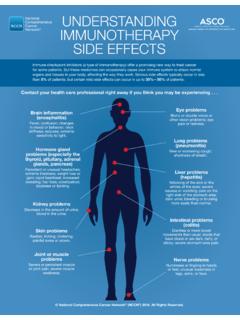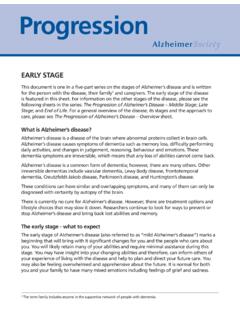Transcription of NCCN Guidelines for Patients Survivorship for Cancer ...
1 2020 Available online at Patients Please complete our online survey with support from: Survivorship Care for Cancer -Related late and Long-Term Effects 1 NCCN Guidelines for Patients : Survivorship Care for Cancer -Related late and Long-Term Effects, 2020 Survivorship Care for Cancer -Related late and Long-Term EffectsIt's easy to get lost in the Cancer world 9 Step-by-step guides to the Cancer care options likely to have the best results 9 Based on treatment Guidelines used by health care providers worldwide 9 Designed to help you discuss Cancer treatment with your doctorsLet NCCN Guidelines for Patients be your guide 2 NCCN Guidelines for Patients : Survivorship Care for Cancer -Related late and Long-Term Effects, 2020 AboutThese NCCN Guidelines for Patients are based on the NCCN Guidelines for Survivorship (Version , July 14, 2020). 2020 National Comprehensive Cancer Network, Inc.
2 All rights reserved. NCCN Guidelines for Patients and illustrations herein may not be reproduced in any form for any purpose without the express written permission of NCCN. No one, including doctors or Patients , may use the NCCN Guidelines for Patients for any commercial purpose and may not claim, represent, or imply that the NCCN Guidelines for Patients that have been modified in any manner are derived from, based on, related to, or arise out of the NCCN Guidelines for Patients . The NCCN Guidelines are a work in progress that may be redefined as often as new significant data become available. NCCN makes no warranties of any kind whatsoever regarding its content, use, or application and disclaims any responsibility for its application or use in any Foundation seeks to support the millions of Patients and their families affected by a Cancer diagnosis by funding and distributing NCCN Guidelines for Patients .
3 NCCN Foundation is also committed to advancing Cancer treatment by funding the nation s promising doctors at the center of innovation in Cancer research. For more details and the full library of patient and caregiver resources, visit National Comprehensive Cancer Network (NCCN) / NCCN Foundation 3025 Chemical Road, Suite 100 Plymouth Meeting, PA 19462 Guidelines for Patients are developed by the National Comprehensive Cancer Network (NCCN )and supported by funding from NCCN Foundation NCCN 9 An alliance of leading Cancer centers across the United States devoted to patient care, research, and educationCancer centers that are part of NCCN: NCCN Guidelines for Patients9 Present information from the NCCN Guidelines in an easy-to-learn format9 For people with Cancer and those who support them 9 Explain the Cancer care options likely to have the best resultsFree online at NCCN Clinical Practice Guidelines in Oncology (NCCN Guidelines )9 Developed by doctors from NCCN Cancer centers using the latest research and years of experience9 For providers of Cancer care all over the world 9 Expert recommendations for Cancer screening, diagnosis, and treatmentFree online at 3 NCCN Guidelines for Patients .
4 Survivorship Care for Cancer -Related late and Long-Term Effects, 2020 SupportersSponsored by Good Days is proud to support this educational resource for Patients and their families and offers unwavering commitment to those who struggle with chronic disease, Cancer , and other life-altering conditions. byAmerican Lung AssociationThe American Lung Association strongly supports efforts to help ensure all Patients facing lung Cancer get the highest standard of treatment and care. Helping Patients understand treatment Guidelines is one important step in empowering them to get the care they want and need. That is why we are pleased to endorse NCCN s efforts to provide accessible treatment Guidelines and information to Patients through the NCCN Guidelines for Patients . The Match National Marrow Donor Program (NMDP)/Be The Match is the global leader in providing a possible cure to Patients with life-threatening blood and marrow cancers, as well as other diseases.
5 Our Be The Match Patient Support Center provides support, information, and resources for Patients , caregivers, and families. Hope NetworkAs an organization committed to providing peer mentorship and ensuring that no one faces Cancer alone, Cancer Hope Network is proud to endorse the informative, straightforward NCCN Patient Guidelines . These Guidelines are a valuable tool for Patients , caregivers and survivors, empowering them to live the best version of their lives while facing Cancer . Your Skin Foundation Save Your Skin Foundation (SYSF) is a Canadian patient-led not-for-profit group dedicated to the fight against non-melanoma skin cancers, melanoma and ocular melanoma. By using and sharing the valuable and thorough NCCN Guidelines , SYSF is confident in their provision of solid patient support with accurate and current information on these cancers and related topics such as skin Cancer treatment with immunotherapy.
6 Leukemia & Lymphoma SocietyThe Leukemia & Lymphoma Society (LLS) is dedicated to developing better outcomes for blood Cancer Patients and their families through research, education, support and advocacy and is happy to have this comprehensive resource available to Patients . generous support fromGena and Dan CookCrystal Denlinger, MD in honor of Edgar and Cynthia Denlinger in honor of Joan McClureKristina GregoryMelissa Hudson, MDWui-Jin Koh, MD in honor of Judith Anne Hanada KohTerry LangbaumJavid Moslehi, MDLindsay Peterson, MDWilliam PiriTo make a gift or learn more, please visit or e-mail Guidelines for Patients : Survivorship Care for Cancer -Related late and Long-Term Effects, 20205 NCCN Guidelines for Patients : Survivorship Care for Cancer -Related late and Long-Term Effects, 2020 Survivorship Care for Cancer -Related late and Long-Term EffectsContents6 Survivorship11 Hormones and hot flashes17 Cardiovascular disease24 Lymphedema30 Cognitive dysfunction34 Sexual dysfunction41 Fatigue46 Sleep52 Pain59 Distress and mental health63 Resources69 Words to know71 NCCN Contributors72 NCCN Cancer Centers74 Index6 NCCN Guidelines for Patients : Survivorship Care for Cancer -Related late and Long-Term Effects, 202061 Survivorship7 Cancer survivors7 Survivorship care9 Survivorship guidelines10 Review7 NCCN Guidelines for Patients : Survivorship Care for Cancer -Related late and Long-Term Effects, 20201 Survivorship Cancer survivors1 Survivorship Cancer survivors | Survivorship carePeople with Cancer are living longer than they did in the past.
7 They are surviving, and their needs have changed. Survivorship care includes recovering from Cancer and promoting survivorsOver the past 40 years, Cancer care has greatly improved. Cancer screening is finding Cancer at early stages when it can be fully removed. Newer treatments are more precise and better at stopping Cancer better Cancer care, people with Cancer are living longer. As a result, the needs of the Cancer community have changed. More people need help to recover from Cancer and its treatment and to be healthy. The term Cancer survivor was proposed in the 1980s. The intent of the term was to raise awareness of better outcomes and changing needs. A person with Cancer is a survivor: starting at the time of diagnosis, during and right after treatment, and through the balance of their people do not like or identify with the term survivor. It is not meant to be a label.
8 Its purpose is to identify the community of people with a history of Cancer . Having a common term is useful for improving the care of careThe large and rising number of Cancer survivors need Survivorship care. Survivorship care improves health, wellness, and quality of life. Standards of Survivorship care are listed in Guide 1. PreventionPrevention of a new or recurring Cancer is a key part of Survivorship care. You can reduce your risk of Cancer with healthy living. Healthy living includes physical activity, eating well, and not using often, medical treatments are used to prevent Cancer . Some people have surgery to remove a body part, like a breast, where Cancer is likely to start. Some people take medication Guide 1 Standards for Survivorship carePrevention of new and recurrent cancersPrevention of late effects of Cancer and treatmentRoutine testing for the return of a Cancer (surveillance)Routine testing for new cancers (screening)Assessment and treatment of late effects of Cancer and treatmentCoordinated care between providersPlanning for ongoing Survivorship care8 NCCN Guidelines for Patients : Survivorship Care for Cancer -Related late and Long-Term Effects, 20201 Survivorship Survivorship carethat lowers hormone levels to reduce the chance of getting Cancer , other unwanted effects of treatment and Cancer can occur after treatment.
9 A goal of Survivorship care is to lower your chance of having these late effects. If detected early, treatment for a late effect may reduce its impact on your surveillanceCancer that was thought to be cured can reappear on tests. The return of Cancer is called a recurrence or relapse. Survivorship care includes routine checking for a recurrence. This is called surveillance. Surveillance often includes updating your health history and a physical exam. Some survivors get blood tests or imaging like x-rays or for cancerCancer screening is routine testing of Cancer or pre- Cancer conditions. The aim is to detect Cancer at an early stage when treatment works best. There is screening for prostate, breast, cervical, skin, lung, and colorectal cancers. Screening is started when there is an average or high risk of Cancer . Ask your health care provider what screening, if any, you have a higher risk of a new (second) Cancer .
10 Ask your health care provider about your chance of getting a second Cancer . Some causes of a first Cancer may be related to getting a second Cancer . Some Cancer treatments may increase Cancer risk. Such treatments include radiation therapy, certain chemotherapies, and certain targeted therapies. Excess radiation from a lifetime of computed tomography (CT) scans slightly increases Cancer risk. Ask your provider if these scans are needed and for how survivors are at risk of hereditary cancers. Hereditary Cancer is caused by abnormal genes that are passed down from parents to children. Cancers that can be hereditary include breast, ovarian, colorectal, and prostate health visits, update your health care providers on any new cancers among your blood relatives. Your provider may suggest getting genetic testing. A blood sample is needed. You may talk with a genetic counselor to discuss your family s Cancer effectsMany effects of treatment quickly resolve after treatment ends.












